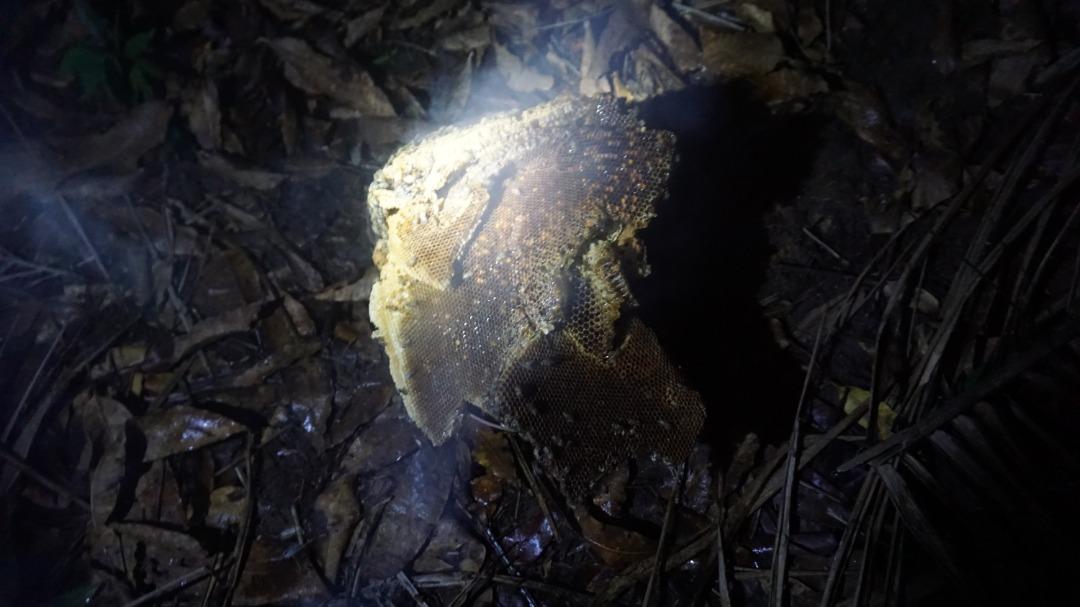First harvest of “manatee honey” at Lake Ossa
In May 2020, the AMMCO team met with one of the fishermen, converted to beekeeping, to collect the first liter of honey. Only one liter? The results seem meager but encouraging. Here is the story of the project.
Beekeeping is one of the alternative activities to fishing launched by AMMCO with the communities of Lake Ossa in order to limit the impact on the lake's resources and the manatee. We talked about the launch of this activity in a previous article and in the 2019 annual report, the initial stage of which was the training in late 2018 of 51 fishermen and the installation of 27 beehives.
Among the 51 fishermen who attended the training, 27 of them came to retrieve the beehives that were offered by AMMCO. These beehives have been installed on 5 sites in Dizangue: Beach, Kilometer 3, Pongo, Mevia and Lindema.
The Lake Ossa Wildlife Reserve is rich in flowers and provides an environment conducive to the life of bees. Bees are also frequently observed on agro-industrial crops located near the reserve, especially those of palm plantations.
However, we observed that the bees did not stay in the hives after their installation. Only 5 hives out of 27 were colonized, and this on the Beach site: One of the hives developed a colony and produced honey, another had 2 or 3 immature honeycombs, but the bees came out after 2 to 3 months and the other three beehives were visited but no honeycomb was created.
Beekeeping requires the intensive preparation of hives in order to develop bee colonies. Without this continuous effort, the bees have little chance of visiting the hives, colonizing them and making the combs in which they will lay the synthesized honey.
The main step is to bait the bees. This is accomplished by coating the inside of the beehives with beeswax, which you buy from a local merchant and melt in a pot. It is important to repeat this operation regularly, every week. It is simply not enough to paint the hive just once.
Of the 27 fishermen who came to collect the beehives, 5 fishermen remained really committed to the project. One of the fishermen in fact soaked his hive with palm wine which also attracts bees. Another fisherman also used local herbs in addition to palm wine. These fishermen also regularly cleared the area around their hives and above all protected them from bad weather with tarpaulins. Built with local materials, the vast majority of beehives that have not been maintained and protected have been destroyed by inclement weather and are currently unrecoverable.
Despite the overall negligible result with only 5 beehives visited out of the total of 27 beehives installed, the results remain very encouraging if we take into account the 5 fishermen who remained active during the initial duration of the project.
After 4 months of colonization, depending on the colony's effort, the bees make the honey inside the combs. This is the ideal time to harvest honey. Passed 5 months, the queen mother produces larvae in these combs that will use the honey as food for their development. The honey that is harvested with larvae remains consumable for the local population as people traditionally give it therapeutic virtues. It only becomes marketable though if it is pure and devoid of larvae. It was therefore to collect a first liter of pure honey that the AMMCO team met one of the 5 fishermen on May 13, 2020. The honey containing larvae was left in the hive. The fisherman decided to keep the collected honey for his personal consumption.
This first stage of the project was very useful in assessing the success factors of the beekeeping project at Lake Ossa. The next step is clear: Select a more committed group of future beekeepers, in this case 5 fishermen from the SIREN network and 5 women from the association of women beneficiaries of the Beach rotating fund, and take into account the knowledge acquired with a more regular monitoring and maintenance of the hives which will ensure a first production of honey in Lake Ossa.
Eventually, each hive will be able to produce up to 40 liters of honey every four months for an income of around $ 200 per harvest; this is enough to reduce dependence on fishing and consequently the accidental bycatch of manatees in Lake Ossa.


